Comprehensive strategy improves rate of graft survival in high-risk cases
Immunosuppression is the final step in a strategy that begins in the early postoperative stages.
MONTE CARLO – Corneal graft survival can be significantly improved in patients at high risk of rejection if a series of preoperative, intraoperative and postoperarative measures are taken, according to one surgeon.
The prevention of graft failure is a complex strategy that begins in the early preoperative stages when the patient’s cornea is first evaluated, and of which immunosuppression is only the final step, said Harminder Dua, MD, PhD, FRCS, FRCOphth, speaking at the winter meeting of the European Society of Cataract and Refractive Surgeons.
Immune rejection is the most common cause of failure, and while 90% of low-risk grafts succeed, 50% to 70% of high-risk grafts fail, he said, citing recent statistics.
“With the strategy we use, we achieved more than 60% of high-risk graft survival,” Dr. Dua said.
Preoperative procedures
The first step consists of identifying high-risk patients. Vascularized corneas, multiple previous corneal grafts, extremes of age, inflamed tissues, infected eyes, herpes simplex viral keratitis, chemical burns and silicone keratopathy are high risk factors, he said.
A risk score system, similar to the one in use at Nottingham University Eye Clinic, can help classify the risk index on the basis of selected parameters to which a numeric score is attributed.
“Preoperatively, try as much as possible to quiet the eye,” he said, “Steroids, but also glue might be very useful, even in the presence of infection.”
Blood vessel occlusion has a primary role in preparing the eye for grafting and can be performed with either argon laser or yellow diode laser, or by fine needle diathermy, Dr. Dua suggested.
“I use this technique as a routine, even with mature, active blood vessels. You take a monofilament nylon needle – I use the Alcon needle – place it along the blood vessel and touch it with the tip of a monopolar diathermy at a very low setting. Meanwhile, the patient touches the other electrode. I usually wrap it around his or her leg,” Dr. Dua explained.
With this method, he said, blood vessels are occluded in a safe and effective way, and haze and opacities produced by the procedure are cleared without unwanted side effects.
Argon laser is equally effective but causes damage to the underlying iris tissue. In herpetic scars, it thins the cornea and might therefore produce localized areas of ectasia, which would in turn require larger grafts, Dr. Dua pointed out.
Table.
Source: Dua H | ||||||||||||||
Intraoperative procedures
Intraoperatively, graft sizing is important, Dr. Dua said. The general rule is “the smaller the graft, the better, in terms of risk of rejection.”
Interrupted sutures are better than continuous sutures, he said, because “if they loosen due to the irregularity in the host bed or to vascularization, you can take them off. In these cases, a running stitch might jeopardize your whole graft.”
Dr. Dua prefers mersilene sutures, which he said are more resistant in the long term. Intraoperatively, steroids can be injected as a bolus and a patch of amniotic membrane can be placed on the graft, Dr. Dua said.
“There is anecdotal evidence that amniotic membrane patching lowers the risk of graft rejection,” he said.
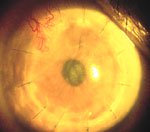 | 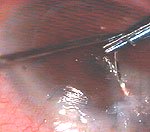 | 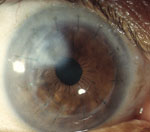 |
| A monofilament nylon needle is placed along the blood vessel and touched with the tip of a monopolar diathermy at a low setting. The patient holds the other electrode. | ||
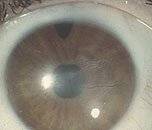 | 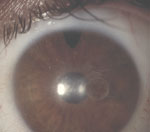 | 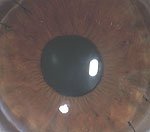 |
| Argon laser occlusion can produce stromal thinning and localized corneal ectasia in herpetic corneal scars. Large penetrating keratoplasty may be necessary, with all its related risks. Images: Dua H | ||
Postoperative procedures
Finally, Dr. Dua outlined how to go safely through the critical postoperative stages.
In the early postoperative period, he said, IOP should be carefully monitored, as IOP elevation represents a major risk factor for failure.
In high-risk patients, topical steroids should be administered for longer than usual with a gradual taper, according to Dr. Dua.
He noted that oral prophylaxis with acyclovir should be used in patients with herpes simplex keratitis for up to 18 months, as it significantly decreases the recurrence of herpetic eye disease and therefore the risk of rejection.
For systemic immunosuppression, Dr. Dua uses tacrolimus, a drug similar to cyclosporine, but he said there are a number of alternatives available.
Tacrolimus is a specific inhibitor of T-cell receptor mediated signal transduction for IL2 production, he explained. The dose is 2 mg to 12 mg a day divided in two daily doses to achieve a trough level of 1 µg/L to 12 µg/L.
High success rate
Dr. Dua said that of 60 patients who underwent corneal grafting with these procedures in his clinic, 43 patients with a follow-up period ranging from 2 months to 6 years were analysed.
“We had 10 graft failures for non rejection-related reasons like infections, epithelial defects and glaucoma. Reversible rejection occurred in eight cases and irreversible rejection in five cases, in spite of systemic immunosuppression. We ended up with a total of 28 clear grafts, with a mean follow up of 33.7 months,” Dr. Dua said.
For Your Information:
- Harminder Dua, MD, PhD, FRCS, FRCOphth, can be reached at the division of ophthalmology, University of Nottingham, Nottingham, UK. Phone +44-115-9709796; fax: +44-115-9709963; e-mail: harminder.dua@nottingham.ac.uk.
- Michela Cimberle is an OSN Correspondent based in Treviso, Italy, who covers all aspects of ophthalmology. She focuses geographically on Europe.
